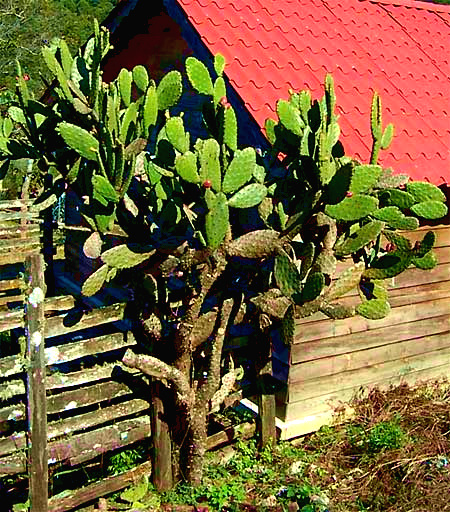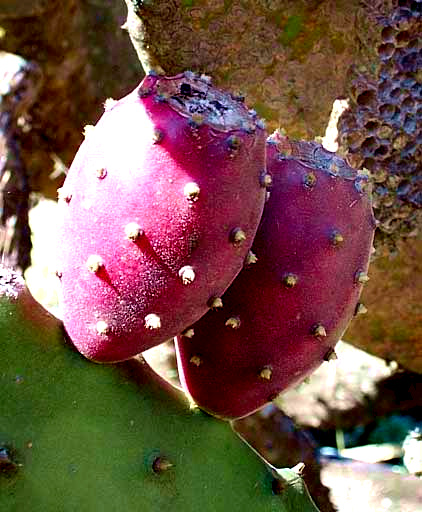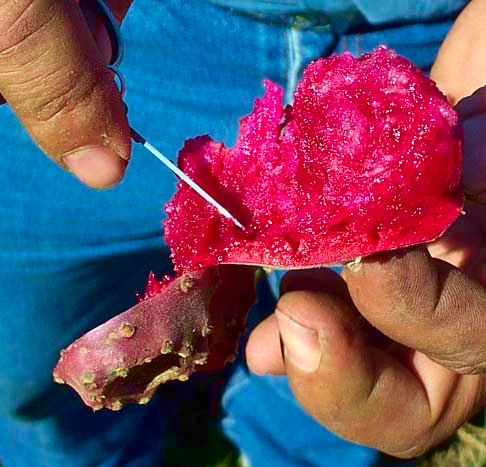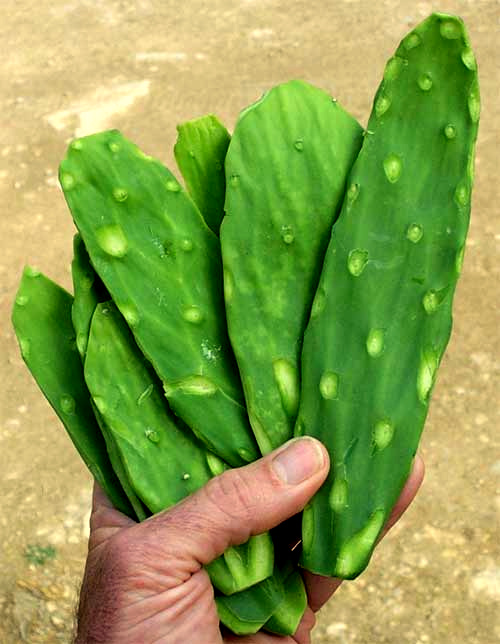Excerpts from Jim Conrad's
Naturalist Newsletter
from the December 18, 2006 Newsletter issued from Sierra Gorda Biosphere Reserve, QUERÉTARO, MÉXICO
HOW PANCHO OPENED HIS TUNA
A number of Spanish words are known to English speakers trying to learn Spanish as "false friends." Many English words have been taken into Spanish and mean what they look like they mean, so they're "real friends." For example, the Spanish word "bar" means "bar" in English. So does "sex-appeal." But other words look like English words, but aren't, and so are "false friends." For example, the Spanish word
"pan" means "bread." Spanish "arena" means "sand."
"Once" means "eleven" and "red" means "net." That's the way it is with "tuna." In Spanish a tuna is an edible cactus fruit.
So, up at San Juan de los Durán there was this Nopal Cactus, OPUNTIA FICUS-INDICA, about 12 feet tall behind one of the bungalows bearing several pretty, red fruits, or tunas, which taste good. You can see that very cactus below:

Now, many cactuses bear two kinds of spines. One kind is the hard, sharp spine everyone visualizes cactuses having, but then there are tufts of often honey-colored, extremely sharp, tiny spines called "glochids" at the spine bases or where spines might grow. You touch one of those glochids and you end up picking at it for days trying to get it out of your skin. You almost have to have good eyes and tweezers to get those things out. A close-up of two tunas in which you can clearly see the glochid tufts with no associated spines is below:

The tunas in that picture are about egg-size, but in markets you can buy special horticultural kinds that are much larger and without glochids, or almost without. The Nopal Cactus has been horticuluralized for so long that quite a few varieties have been developed. The cactus in these pictures is an old type.
So, I had a good-tasting fruit covered with glochids I didn't want to touch. How could I get at the edible part without ruining my fingers for several days? I've tried various techniques and I've always ended up with at least one glochid in a finger, so up at San Juan de los Durán I didn't even try to open a tuna.
However, my friend Pancho, the truck driver, eventually came along so I asked him how he'd eat it. He gave me that look that only a Mexican can give a gringo when the gringo is being hopelessly helpless. He took a fruit between two sticks chopstick-like, and told me to follow him. We went over to the bunch of weeds near the spring where the Rufous-capped Warblers had tarried, dropped the tunas onto the ground, broke off several switches from an assortment of soft-leafy weeds, and set about vigorously brushing the tunas with his weed-switch. After about 45 seconds he picked up a tuna with his fingers, sliced it open, and held it before me to eat. Before I ate it I took its picture, which you can see below:

And, indeed, Pancho didn't get a single glochid out of the deal. Through all these years of wandering in cactus country, why hadn't I thought of switching tunas with soft-leafy weeds?
The picture shows that tuna fruits are red and succulent inside, looking almost like watermelon flesh. The taste is even a little like watermelon. However, the scarlet pulp is full of small seeds, so you're faced with the same question as when you eat passion fruits or pomegranates: Do you spit out each little seed or swallow them?
I asked Pancho what Mexicans did. He said that some spit, some swallow. He, personally, was a swallower. By the time he'd told me all that I'd already swallowed mine.
from the March 17, 2007 Newsletter issued from Sierra Gorda Biosphere Reserve, QUERÉTARO, MÉXICO
NOPAL AT THE WINDOW
Monday morning I was working in my little casita when someone outside by window loudly said "¡Buenos días, buenos días... !" I parted by curtains and there stood Don Gonzalo with his usual big smile. He'd brought me a plastic bag of Nopal cactus pads ready to turn into the delicious dish called "nopalitos." You can see those very pads moments before I sliced them up below:

In that picture you can admire the conscientious job the don did preparing the pads. He chose young pads still in their long, slender, tender stage, he shaved off every bump on each pad where there conceivably could be a glochid -- one of those tiny, almost invisible stickers at the base of normal spines -- and he'd excised the rims, which are the toughest parts, and where there'll be glochids if there's any glochid at all. I was touched, for it takes a little time to prepare cactus pads like this.
At http://www.gourmetsleuth.com/nopalitos.htm you can read a lot about nopalitos, surf to a link showing a new gadget designed just for glochid removal, and see a tasty-sounding recipe for nopalitos requiring:
I didn't make that recipe. All I did was to cut my pads into my black solar-oven bowl, top them with chopped onions, sliced jalapeños and two raw eggs. When this had cooked to the point that the nopal pieces were soft and a little slimy, the onions were smelling awfully good, and the jalapeños hadn't yet lost their sting, I topped it all with chopped tomatoes, salted lightly, and spritzed it with a little vinegar and oil.
That was good, people. I still salivate just thinking about it.